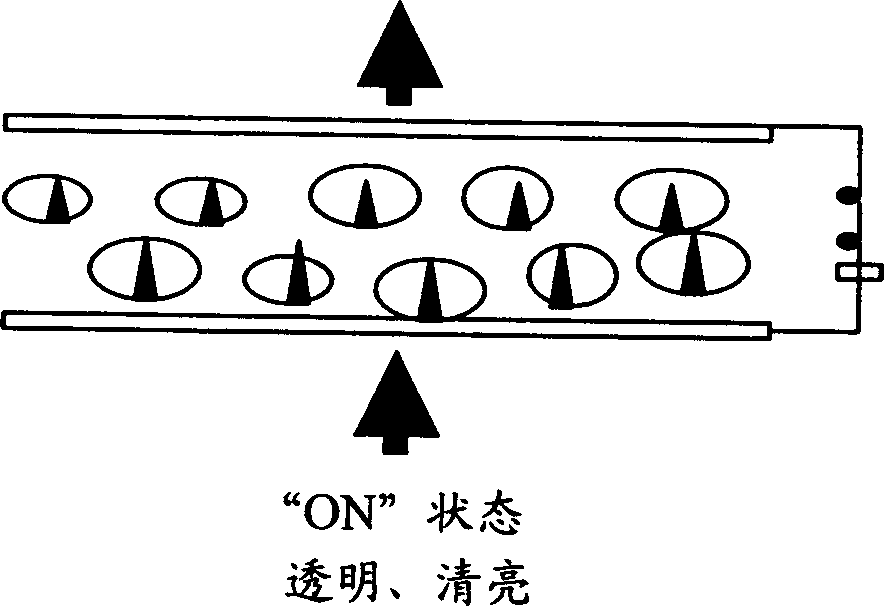Transmissive or reflective liquid crystal display and novel process for its manufacture
A liquid crystal display and composition technology, applied in the direction of instruments, other household appliances, thin material processing, etc., to achieve the effects of easy specification diversification, easy operation, and improved switching speed
- Summary
- Abstract
- Description
- Claims
- Application Information
AI Technical Summary
Problems solved by technology
Method used
Image
Examples
preparation example Construction
[0048] I. Preparation of Microcups
[0049] Microcup arrays can be fabricated by micromolding, photolithography, or pre-perforation methods, as in WO 02 / 56097 and U.S. Application No. 09 / 942,532 filed August 29, 2002 (U.S. Publication No. 2002-75556, published in 2002 June 20), both of which are hereby incorporated by reference.
[0050] Suitable compositions for making these microcups are also disclosed in these references. Examples of compositions for micromolding or photolithography (disclosed in WO 02 / 56097) include thermoplastics, thermosets or precursors thereof such as multifunctional acrylates or methacrylates, vinyl esters, epoxides and their oligomers, polymers or the like. In one particular embodiment, multifunctional acrylates and their oligomers can be used. The combination of multifunctional epoxides and multifunctional acrylates is also beneficial to obtain desirable physical and mechanical properties. Typically, a flexibility-imparting cross-linkable oligom...
Embodiment 1
[0099] Embodiment 1 makes microcup by micromolding
[0100] The compositions shown in Table 1 were coated onto 2 mil PET film pre-coated with an ITO conductive layer (ITO / PET film, 5 mil OC50, from CPFilms, Martinsville, VA) using a No. 6 Myrad rod. . A pre-imaged (4 μm width x 4 μm length x 4 μm height x 4 μm separation) cobalt-nickel punch and release agent Frekote 700-NC from the Henkel company were used for micromolding. Coating thickness is controlled at about 5 microns. The coated film was then embossed with the punch using a press roll at 90°C. The coating was then cured by UV light through a Mylar film for about 1 minute using a Cure Zone exposure device (ADAC Technologies) equipped with a metal fluoride lamp with an intensity of 80 mW at 365 nm / cm 2 . The embossed film was then demolded to reveal microcups (4 μm width x 4 μm length x 4 μm depth x 4 μm separation). The micromolding was performed at 90°C using a GBC laminator.
[0101] Numbering
Embodiment 2
[0102] Embodiment 2 makes microcup by micromolding
[0103] Coating was carried out using the same procedure as in Example 1, using the formulation in Table 2, and molding was carried out with the same 4x4x4x4 μm punch.
[0104] Numbering
[0105] A No. 12 Myrad rod was used. The target coating thickness is about 5 microns. The micro embossing was done using a press roll (GBC laminator) heated to 90°C.
PUM
| Property | Measurement | Unit |
|---|---|---|
| glass transition temperature | aaaaa | aaaaa |
| density | aaaaa | aaaaa |
| density | aaaaa | aaaaa |
Abstract
Description
Claims
Application Information
 Login to View More
Login to View More - R&D
- Intellectual Property
- Life Sciences
- Materials
- Tech Scout
- Unparalleled Data Quality
- Higher Quality Content
- 60% Fewer Hallucinations
Browse by: Latest US Patents, China's latest patents, Technical Efficacy Thesaurus, Application Domain, Technology Topic, Popular Technical Reports.
© 2025 PatSnap. All rights reserved.Legal|Privacy policy|Modern Slavery Act Transparency Statement|Sitemap|About US| Contact US: help@patsnap.com



